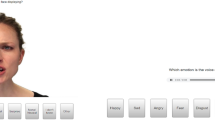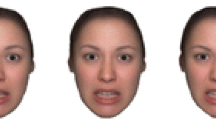Abstract
The congruence between facial expressivity and self-report of emotion was examined among 11 women with sexual assault-related PTSD and 8 women without PTSD, under both a neutral and a sexual assault prime condition. The PTSD group demonstrated some incongruities in emotional responding. Although the PTSD group was as facially expressive as the control group, they reported more arousal to the emotional stimuli. Further, an inverse relationship between negative facial expressivity and self-report to negative stimuli was found for some variables for the PTSD group only, such that the less expressions they showed facially, the more negative they reported feeling. However, the overall pattern of results suggests fewer significant relationships between expression and experience than predicted.
Similar content being viewed by others
References
American Psychiatric Association. (1994). Diagnostic and statistical manual of mental disorders (4th ed.). Washington, DC: Author.
Blake, D. D., Weathers, F. W., Nagy, L. M., Kaloupek, D. G., Charney, D. S., & Keane, T. M. (1998). Clinician-Administered PTSD Scale for DSM-IV (CAPS-IV). Boston, MA: National Center for Posttraumatic Stress Disorder.
Blanchard, E. B., Jones-Alexander, J., Buckley, T. C., & Forneris, C. A. (1996). Psychometric properties of the PTSD checklist (PCL). Behaviour Research and Therapy, 4, 669–674.
Bradley, M. M., & Lang, P. J. (2000). Affective reactions to acoustic stimuli. Psychophysiology, 37, 204–215.
Buck, R. (1979). Individual differences in nonverbal sending accuracy and electrodermal responding: The externalizing–internalizing dimension. In R. Rosenthal (Ed.), Skill in nonverbal communication (pp. 140–170). Cambridge, MA: Oelgeschlager, Gunn & Hairn.
Cacioppo, J. T., Uchino, B. N., Crites, S. L., Snydersmith, M. A., Smith, G., Berntson, G. G., et al. (1992). Relationship between facial expressiveness and sympathetic activation in emotion: A critical review, with emphasis on modeling underlying mechanisms and individual differences. Journal of Personality and Social Psychology, 62, 110–128.
Center for the Study of Emotion and Attention [CSEA-NIMH]. (1999). The international affective picture system: Digitized photographs. Gainesville, FL: University of Florida, The Center for Research in Psychophysiology.
Cohen, J. (1988). Statistical power analysis for the behavioral sciences (2nd ed.). Hillsdale, NJ: Erlbaum.
Cohen, J., & Cohen, P. (1983). Applied multivariate regression for the behavioral sciences (2nd ed.). Hillsdale, NJ: Erlbaum.
Derogatis, L. R., & Spencer, P. M. (1982). Brief Symptom Inventory: Administration, scoring, and procedures manual-I. Baltimore: Clinical Psychometric Research.
Foa, E. B., & Rothbaum, B. O. (1998). Treating the trauma of rape: Cognitive–behavioral therapy for PTSD. New York: Guilford Press.
Foa, E. B., Zinbarg, R., & Rothbaum, B. O. (1992). Uncontrollability and unpredictability in post-traumatic stress disorder: An animal model. Psychological Bulletin, 112, 218–238.
Gross, J. J., & John, O. P. (1997). Revealing feelings: Facets of emotional expressivity in self-reports, peer ratings, and behavior. Journal of Personality and Social Psychology, 72, 435–448.
Gross, J. J., & Levenson, R. W. (1993). Emotional suppression: Physiology, self-report, and expressive behavior. Journal of Personality and Social Psychology, 64, 970–986.
Gross, J. J., & Levenson, R. W. (1997). Hiding feelings: The acute effects of inhibiting negative and positive emotion. Journal of Abnormal Psychology, 106, 95–103.
Horowitz, M. J. (1986). Stress response syndromes (2nd ed.). Northvale, NJ: Jason Aronson Press.
Jaycox, L. H., & Foa, E. B. (1996). Obstacles in implementing exposure therapy for PTSD: Case discussions and practical solutions. Clinical Psychology and Psychotherapy, 3, 176–184.
Jaycox, L. H., Foa, E. B., Morral, A. R. (1998). Influence of emotional engagement and habituation on exposure therapy for PTSD. Journal of Consulting and Clinical Psychology, 66, 185–192.
Keane, T. M., Fairbank, J. A., Caddell, J. M., Zimering, R. T., & Bender, M. E. (1985). A behavioral approach to assessing and treating post-traumatic stress disorder in Vietnam veterans. In C. R. Figley (Ed.), Trauma and its wake (pp. 257–294). New York: Brunner-Mazel.
Kring, A. M., & Sloan, D. (1992). The facial expression coding system (FACES): A user's guide. Unpublished manuscript.
Kring, A. M., Smith, D. A., & Neale, J. M. (1994). Individual differences in dispositional expressiveness: Development and validation of the Emotional Expressivity Scale. Journal of Personality and Social Psychology, 66, 934–949.
Lang, P. J., Bradley, M. M., & Cuthbert, B. N. (1999). International affective picture system (IAPS): Technical Manual and Affective Ratings. Gainesville, FL: University of Florida, The Center for Research in Psychophysiology.
Lang, P. J., Greenwald, M. K., Bradley, M. M., & Hamm, A. O. (1993). Looking at pictures: Affective, facial, visceral, and behavioral reactions. Psychophysiology, 30, 261–273.
Levenson, R. W. (1994). Human emotion: A functional view. In P. Ekman & R. J. Davidson (Eds.), The nature of emotion: Fundamental questions (pp. 123–126). New York: Oxford University Press.
Litz, B. T. (1992). Emotional numbing in combat-related post-traumatic stress disorder: A critical review and reformulation. Clinical Psychology Review, 12, 417–432.
Litz, B. T., Orsillo, S. M., Kaloupek, D., & Weathers, F. (2000). Emotional-processing in posttraumatic stress disorder. Journal of Abnormal Psychology, 109, 26–39.
Notarius, C. I., & Levenson, R. W. (1979). Expressive tendencies and physiological response to stress. Journal of Personality and Social Psychology, 37, 1204–1210.
Pitman, R. K., Orr, S. P., Forgue, D. F., de Jong, J. B., & Claiborn, J. M. (1987). Psychophysiologic assessment of posttraumatic stress disorder imagery in Vietnam combat veterans. Archives of General Psychiatry, 44, 970–975.
Roemer, L., Orsillo, S. M., Litz, B. T., & Wagner, A. W. (2001). A preliminary investigation of the role of strategic withholding of emotions in PTSD. Journal of Traumatic Stress, 14, 143–150.
Rosenberg, E. L., & Ekman, P. (1994). Coherence between expressive and experiential systems in emotion. Cognition and Emotion, 8, 201–229.
Author information
Authors and Affiliations
Corresponding author
About this article
Cite this article
Wagner, A.W., Roemer, L., Orsillo, S.M. et al. Emotional Experiencing in Women with Posttraumatic Stress Disorder: Congruence Between Facial Expressivity and Self-Report. J Trauma Stress 16, 67–75 (2003). https://doi.org/10.1023/A:1022015528894
Issue Date:
DOI: https://doi.org/10.1023/A:1022015528894




